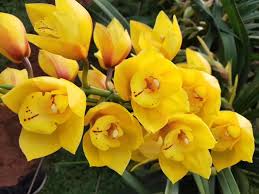# The Historical Development of Sato Cymbidium Orchids Through the Ages

Sato Cymbidium orchids, known for their stunning beauty and resilience, have captured the hearts of plant enthusiasts and florists around the world. Originating from Vietnam, these orchids hold significant cultural and economic value. This article will explore the historical development of Sato Cymbidium orchids through various periods, examining their origins, cultural significance, cultivation advancements, and the impact of global trends on their evolution.
## 1. Origins of Sato Cymbidium Orchids
### 1.1 Ancient Beginnings
The Sato Cymbidium orchid, part of the larger genus Cymbidium, is believed to have originated in tropical and subtropical regions of Asia. Historical records suggest that these orchids have been cultivated for centuries, with evidence of their presence in ancient civilizations such as the Chinese and Vietnamese cultures.
– **Cultural Significance:** In ancient China, orchids symbolized elegance and refinement. They were often associated with scholars and aristocrats, who appreciated their beauty and rarity. In Vietnamese culture, orchids are regarded as a symbol of prosperity and are frequently used in traditional ceremonies, including weddings and lunar New Year celebrations.
– **Early Cultivation:** Evidence of early orchid cultivation dates back to the Tang Dynasty (618–907 AD) in China, where orchids were grown in royal gardens. The admiration for these flowers spread across Asia, and their cultivation became a revered art form.
### 1.2 The Role of Traditional Medicine
Orchids, including the Sato Cymbidium, have also played a crucial role in traditional medicine. In various Asian cultures, different parts of the orchid plant have been used for medicinal purposes.
– **Herbal Remedies:** Traditional Chinese medicine has utilized orchids for their supposed health benefits, including treating respiratory ailments, improving skin conditions, and boosting the immune system. Sato Cymbidium orchids, in particular, have been recognized for their cooling properties and are often used in herbal concoctions.
– **Cultural Practices:** The medicinal use of orchids is closely intertwined with cultural practices and beliefs. For example, orchids are sometimes used in rituals and offerings to promote health and well-being, further embedding them in the cultural fabric of Asian societies.
## 2. Development Through the Ages
### 2.1 The Ming and Qing Dynasties
During the Ming (1368–1644) and Qing (1644–1912) dynasties, the cultivation of orchids reached new heights in China, and the Sato Cymbidium gained recognition for its unique characteristics.
– **Cultural Revival:** The Ming Dynasty saw a revival of interest in the arts and culture, including horticulture. Scholars and artists began to cultivate and study orchids, resulting in a greater appreciation for their beauty and diversity. This period marked the beginning of systematic orchid classification.
– **Horticultural Advancements:** The Qing Dynasty further advanced orchid cultivation through improved techniques and methods. Orchid nurseries flourished, and the Sato Cymbidium became a favorite among collectors. The demand for these orchids increased, leading to the development of specialized growing techniques and hybridization.
### 2.2 Colonial Influence and Global Trade
The colonial period in the 19th and early 20th centuries had a significant impact on the Sato Cymbidium orchid’s development and spread beyond Asia.
– **Exporting Orchids:** As European powers expanded their reach, they became fascinated with exotic plants, including orchids. The trade of orchids flourished, and the Sato Cymbidium was exported to various countries, particularly in Europe and America. This global interest helped establish a wider market for these orchids.
– **Hybridization and Innovation:** The influx of foreign botanists and horticulturists led to extensive hybridization efforts. Sato Cymbidium orchids were crossbred with other orchid species to create new varieties with unique colors, shapes, and sizes. This era marked a turning point in orchid cultivation, as hybrid orchids became increasingly popular among collectors and enthusiasts.
## 3. The Modern Era: Cultivation and Commercialization
### 3.1 Post-World War II Developments
Following World War II, the orchid industry experienced a boom, with advancements in cultivation techniques and increased demand for ornamental plants.
– **Commercial Cultivation:** The Sato Cymbidium orchid gained prominence as a commercial crop in Vietnam and other orchid-producing countries. Growers began to establish nurseries dedicated to cultivating these orchids, leading to mass production and distribution.
– **Innovation in Growing Techniques:** The post-war period saw the introduction of modern horticultural practices, including the use of fertilizers, pest control methods, and improved irrigation systems. These innovations significantly enhanced orchid production and quality.
### 3.2 The Rise of the Orchid Industry in Vietnam
Vietnam emerged as a key player in the global orchid market, with the Sato Cymbidium becoming one of the country’s flagship products.
– **Government Support:** The Vietnamese government recognized the potential of the orchid industry for economic growth and provided support to growers through research, training, and marketing initiatives. This assistance helped boost the cultivation of Sato Cymbidium orchids.
– **Export Growth:** The demand for Sato Cymbidium orchids in international markets, particularly in Europe and North America, increased. Vietnamese growers began exporting their orchids, contributing to the country’s economic development and establishing a reputation for high-quality flowers.
## 4. Cultural Significance in Modern Society
### 4.1 Symbolism and Aesthetics
In contemporary society, the Sato Cymbidium orchid continues to hold cultural significance and is widely appreciated for its aesthetic appeal.
– **Cultural Festivals:** Sato Cymbidium orchids are prominently featured in cultural festivals and events in Vietnam. They symbolize good fortune and prosperity and are often used as decorative elements in homes, businesses, and during celebrations.
– **Interior Design Trends:** The popularity of Sato Cymbidium orchids in interior design has surged, with their elegant blooms being used in floral arrangements and home decor. Their ability to thrive in various environments makes them a favored choice among plant enthusiasts.
### 4.2 Educational and Research Initiatives
The increasing interest in Sato Cymbidium orchids has led to educational and research initiatives aimed at promoting understanding and appreciation of these plants.
– **Orchid Exhibitions:** Orchid exhibitions and competitions have become popular events, showcasing the diversity and beauty of Sato Cymbidium orchids. These events not only celebrate the plants but also educate the public about their care and cultivation.
– **Research and Conservation Efforts:** Researchers and conservationists are actively studying Sato Cymbidium orchids to ensure their preservation and sustainability. This includes efforts to protect natural habitats and promote responsible cultivation practices.
## 5. Future Prospects and Challenges
### 5.1 Sustainability and Environmental Awareness
As the Sato Cymbidium orchid industry continues to grow, sustainability and environmental awareness are becoming increasingly important.
– **Eco-Friendly Practices:** Growers are adopting eco-friendly practices, such as organic fertilizers and integrated pest management, to minimize their environmental impact. This shift toward sustainable cultivation is crucial for the long-term viability of the industry.
– **Community Engagement:** Involving local communities in orchid cultivation and conservation efforts fosters a sense of responsibility and stewardship. Educating the public about the importance of preserving orchid species can contribute to their protection.
### 5.2 Global Trends and Market Adaptation
The Sato Cymbidium orchid industry must adapt to changing global trends to remain competitive.
– **Consumer Preferences:** Understanding consumer preferences for unique and exotic varieties is essential for growers. The demand for rare and hybrid Sato Cymbidium orchids presents opportunities for innovation and diversification.
– **E-commerce and Digital Marketing:** Embracing e-commerce and digital marketing strategies can help growers reach wider audiences and increase sales. Establishing a strong online presence allows for direct engagement with customers and facilitates the distribution of orchids.
## Conclusion
The history of Sato Cymbidium orchids is a rich tapestry woven with cultural significance, botanical innovation, and economic development. From their ancient origins to their modern-day prominence, these orchids have evolved to become a cherished symbol of beauty and resilience.
As the Sato Cymbidium orchid industry continues to grow, it faces both opportunities and challenges. By embracing sustainability, innovation, and community engagement, the industry can secure a bright future. The enduring allure of Sato Cymbidium orchids will undoubtedly continue to captivate generations to come, ensuring their place in the hearts of plant enthusiasts and the cultural landscape of Vietnam and beyond.
# The Historical Development of Sato Cymbidium Orchids Through the Ages (Part 2)
In the first part of our exploration of Sato Cymbidium orchids, we delved into their origins, significance in ancient cultures, and development during the Ming and Qing Dynasties. We also discussed the colonial influences that shaped the global orchid trade and the rise of commercial cultivation in Vietnam. In this second part, we will continue our examination of the historical development of Sato Cymbidium orchids, focusing on modern advancements in cultivation, the cultural impact of these orchids, and their future prospects.
## 6. Modern Advancements in Cultivation
### 6.1 Technological Innovations in Orchid Growing
As we moved into the latter half of the 20th century, the orchid industry witnessed significant technological advancements that revolutionized cultivation practices. These innovations enabled growers to improve both the quality and quantity of Sato Cymbidium orchids.
– **Greenhouse Technology:** The development of modern greenhouse technology allowed for better control over environmental factors such as temperature, humidity, and light. Greenhouses equipped with advanced climate control systems enabled growers to create ideal conditions for Sato Cymbidium orchids, leading to healthier plants and more vibrant blooms.
– **Hydroponics and Soilless Cultivation:** Hydroponic systems and soilless cultivation methods gained popularity among orchid growers. These methods reduce the risk of soil-borne diseases and allow for precise control over nutrient delivery. Sato Cymbidium orchids, when grown hydroponically, can exhibit faster growth rates and more vigorous blooms.
– **Tissue Culture Techniques:** Tissue culture has become a pivotal technique in orchid propagation. This method allows for the rapid multiplication of Sato Cymbidium orchids, producing clones that exhibit uniform characteristics. Tissue culture not only ensures the availability of high-quality plants but also plays a crucial role in conservation efforts by helping preserve rare and endangered orchid varieties.
### 6.2 Sustainable Practices in Orchid Cultivation
With the increasing awareness of environmental issues, sustainable practices have become a focal point in the orchid industry. Growers are adopting eco-friendly approaches to minimize their impact on the environment while maintaining high-quality production.
– **Organic Cultivation:** Many growers are transitioning to organic cultivation methods, using natural fertilizers and pest control strategies. Organic practices not only promote environmental sustainability but also appeal to consumers who prioritize organic products.
– **Water Conservation Techniques:** Efficient water management practices, such as drip irrigation and rainwater harvesting, are being implemented to reduce water consumption. These techniques not only conserve water but also contribute to healthier plant growth by providing consistent moisture levels.
– **Integrated Pest Management (IPM):** Growers are increasingly employing IPM strategies to control pests and diseases while minimizing the use of chemical pesticides. By promoting beneficial insects and using biological controls, growers can effectively manage pests while protecting the environment.
## 7. Cultural Impact and Symbolism
### 7.1 Sato Cymbidium Orchids in Vietnamese Culture
Sato Cymbidium orchids hold a special place in Vietnamese culture, symbolizing prosperity, happiness, and good fortune. Their beauty and elegance make them a popular choice for various occasions and celebrations.
– **Traditional Festivals:** Sato Cymbidium orchids are prominently featured during traditional Vietnamese festivals, including Tết (Lunar New Year) and other cultural celebrations. During Tết, these orchids are often used as decorations in homes and businesses, believed to bring luck and prosperity for the coming year.
– **Weddings and Ceremonies:** In Vietnamese weddings, Sato Cymbidium orchids are frequently incorporated into floral arrangements and bridal bouquets. Their presence adds a touch of elegance and signifies the beauty of love and new beginnings.
– **Art and Literature:** The beauty of Sato Cymbidium orchids has inspired artists and poets throughout history. Their delicate blooms and vibrant colors are often depicted in traditional Vietnamese art, reflecting the cultural appreciation for nature and beauty.
### 7.2 Global Symbolism of Orchids
Beyond Vietnam, Sato Cymbidium orchids have gained international recognition for their symbolic meanings and aesthetic appeal.
– **Symbol of Luxury and Exoticism:** In many cultures, orchids are associated with luxury and exoticism. Their rarity and stunning beauty make them a sought-after gift for special occasions, symbolizing love, admiration, and respect.
– **Cultural Exchange:** As Sato Cymbidium orchids spread to various parts of the world, they became part of cultural exchange. Different cultures have embraced these orchids, incorporating them into their traditions and celebrations, thereby enriching their cultural significance.
## 8. Education and Research Initiatives
### 8.1 Promoting Orchid Education
As interest in Sato Cymbidium orchids grows, educational initiatives have emerged to promote understanding and appreciation of these beautiful plants.
– **Orchid Workshops and Seminars:** Many orchid societies and botanical gardens organize workshops and seminars to educate enthusiasts about orchid care, propagation, and cultivation techniques. These events provide valuable knowledge to both novice and experienced growers.
– **School Programs:** Educational institutions are increasingly incorporating orchid cultivation into their curricula. Programs focused on botany and horticulture often include practical lessons on growing orchids, fostering a new generation of orchid enthusiasts.
### 8.2 Research in Orchid Conservation
The conservation of Sato Cymbidium orchids has become a priority for researchers and conservationists. Their efforts aim to protect these orchids from habitat loss and ensure their sustainability.
– **Field Studies and Habitat Preservation:** Researchers conduct field studies to understand the natural habitats of Sato Cymbidium orchids. By identifying critical habitats and assessing the impact of environmental changes, conservationists can develop strategies to protect these orchids in the wild.
– **Collaboration with Local Communities:** Engaging local communities in conservation efforts is vital for the protection of Sato Cymbidium orchids. By involving communities in sustainable practices and education, conservationists can foster a sense of ownership and responsibility for preserving these beautiful plants.
## 9. Challenges and Opportunities
### 9.1 Challenges in the Orchid Industry
While the future of the Sato Cymbidium orchid industry looks promising, several challenges must be addressed.
– **Climate Change:** Climate change poses significant challenges for orchid growers, affecting temperature, humidity, and rainfall patterns. Adapting cultivation practices to mitigate the impacts of climate change is crucial for the industry’s sustainability.
– **Pest and Disease Management:** The threat of pests and diseases remains a constant challenge in orchid cultivation. Growers must stay informed about emerging threats and adopt effective pest management strategies to protect their crops.
### 9.2 Opportunities for Growth
Despite these challenges, the Sato Cymbidium orchid industry also presents numerous opportunities for growth and innovation.
– **Expanding Markets:** The increasing global interest in ornamental plants provides opportunities for Sato Cymbidium orchids to penetrate new markets. With effective marketing strategies and high-quality products, growers can tap into the growing demand for exotic flowers.
– **Collaboration and Networking:** Collaboration among growers, researchers, and conservationists can lead to innovative solutions and shared knowledge. Building a network of orchid enthusiasts and professionals fosters a sense of community and encourages the exchange of ideas.
## 10. The Future of Sato Cymbidium Orchids
### 10.1 Embracing Innovation and Technology
The future of Sato Cymbidium orchids will likely be shaped by continued innovation and technological advancements.
– **Smart Gardening Technologies:** The integration of smart gardening technologies, such as automated monitoring systems and mobile applications, can help growers optimize their cultivation practices. These tools provide real-time data on environmental conditions, enabling growers to make informed decisions about watering, fertilization, and pest management.
– **Research and Development:** Ongoing research and development in orchid genetics and breeding can lead to the creation of new varieties with enhanced traits, such as disease resistance, unique colors, and improved adaptability. This innovation can contribute to the long-term sustainability of the Sato Cymbidium orchid industry.
### 10.2 Preservation of Cultural Heritage
As the Sato Cymbidium orchid industry evolves, preserving its cultural heritage remains essential.
– **Documentation of Traditional Knowledge:** Efforts to document traditional knowledge about Sato Cymbidium orchids and their cultural significance are crucial for preserving this heritage. This knowledge can be passed down to future generations, ensuring that the appreciation for these orchids endures.
– **Cultural Festivals and Events:** Continued celebration of cultural festivals that highlight Sato Cymbidium orchids will help reinforce their importance in Vietnamese culture. These events not only promote the orchids but also educate the public about their historical and cultural significance.
## Conclusion
The historical development of Sato Cymbidium orchids is a captivating journey that reflects the rich cultural heritage, botanical innovations, and global influences that have shaped their cultivation. From their ancient origins to the modern advancements in horticulture, these orchids have evolved to become cherished symbols of beauty, prosperity, and resilience.
As we look to the future, the Sato Cymbidium orchid industry faces both challenges and opportunities. By embracing sustainable practices, leveraging technological advancements, and preserving cultural heritage, the industry can secure a bright and flourishing future. The enduring allure of Sato Cymbidium orchids will continue to captivate generations to come, ensuring their place in the hearts of plant enthusiasts and the cultural landscape of Vietnam and beyond.

